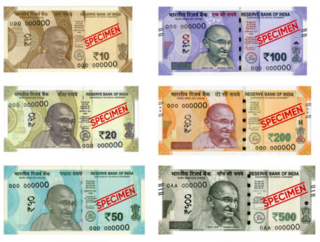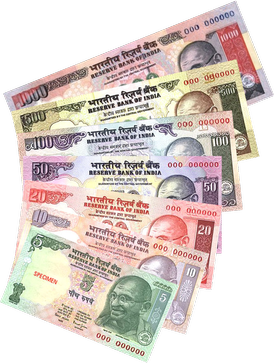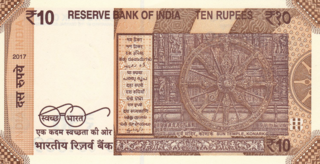Related Research Articles

The Reserve Bank of India is India's central bank and regulatory body responsible for regulation of the Indian banking system. Owned by the Ministry of Finance of the Government of the Republic of India,it is responsible for the control,issue and maintaining supply of the Indian rupee. It also manages the country's main payment systems and works to promote its economic development.

The Indian rupee is the official currency in the Republic of India. The rupee is subdivided into 100 paise. The issuance of the currency is controlled by the Reserve Bank of India. The Reserve Bank manages currency in India and derives its role in currency management based on the Reserve Bank of India Act,1934.

The Mauritian rupee is the currency of Mauritius. One rupee is subdivided into 100 cents. Several other currencies are also called rupee.

The Pakistani rupee is the official currency in the Islamic Republic of Pakistan. The issuance of the currency is controlled by the State Bank of Pakistan. It was officially adopted by the Government of Pakistan in 1949. Earlier the coins and notes were issued and controlled by the Reserve Bank of India until 1949,when it was handed over to the Government and State Bank of Pakistan,by the Government and Reserve Bank of India.

Coins of the Indian rupee (₹) were first minted in 1950. New coins have been produced annually since then and they make up a valuable aspect of the Indian currency system. Today,circulating coins exist in denominations of 1,2,5,10,and 20 rupees. All of these are produced by four mints located across India,in Kolkata,Mumbai,Hyderabad,Noida.

The history of the rupee traces back to ancient times in the Indian subcontinent. The mention of rūpya by Pāṇini is seemingly the earliest reference in a text about coins. The term in Indian subcontinent was used for referring to a coin.

Bhaskar Namdeo Adarkar was the ninth Governor of the Reserve Bank of India from 4 May 1970 to 15 June 1970. His term was the second-shortest after Amitav Ghosh who had served for only 20 days. His term was short since he was filling in as interim before S. Jaganathan took over.
Sarukkai Jagannathan was the tenth Governor of the Reserve Bank of India from 16 June 1970 to 19 May 1975.

Ram Narain Malhotra popularly known as R. N. Malhotra was the seventeenth governor of the Reserve Bank of India (RBI),serving from 4 February 1985 to 22 December 1990.

Lakshmi Kant Singh,MBE,born in Darbhanga district,Bihar was the eighth Governor of the Reserve Bank of India from 1 July 1967 to 3 May 1970.

The Gandhi Series of banknotes are issued by the Reserve Bank of India (RBI) as the legal tender of Indian rupee. The series is so called because the obverse of the banknotes prominently display the portrait of Mahatma Gandhi. Since its introduction in 1996,this series replaced all Lion Capital Series banknotes issued before 1996. The Reserve Bank of India (RBI) introduced the series in 1996 with ₹10 and ₹500 banknotes.

The Indian 1000-rupee banknote is an obsolete denomination of the Indian rupee. It was first introduced by the Reserve Bank of India in 1938 under British rule and subsequently demonetized in 1946. Post-independence,the denomination was re-introduced in 1954. In January 1978,all high-denomination banknotes of ₹1000,₹5000,and ₹10000 were demonetized in order to curb unaccounted cash money.

The Indian 100-rupee banknote is a denomination of the Indian rupee. It has been in continuous production since Reserve Bank of India took over the functions of the controller of currency in India in 1935. The present ₹100 banknote in circulation is a part of the Mahatma Gandhi New Series.

The Indian 20-rupee banknote is a common denomination of the Indian rupee. The current ₹20 banknote in circulation is a part of the Mahatma Gandhi New Series. The Reserve Bank introduced the ₹20 note in the Mahatma Gandhi New Series in 2019,making it the last denomination to be introduced in the series.

The Indian 10-rupee banknote is a common denomination of the Indian rupee. The ₹10 note was one of the first notes introduced by the Reserve Bank of India as a part of the Mahatma Gandhi Series in 1996. These notes are presently in circulation along with the Mahatma Gandhi New Series which were introduced in January 2018,this is used alongside the 10 rupee coin.

The Mahatma Gandhi New Series of banknotes are issued by the Reserve Bank of India (RBI) as the legal tender of the Indian rupee,intended to replace the Mahatma Gandhi Series of banknotes. Announced on 8 November 2016,it followed the demonetisation of ₹500 and ₹1000 banknotes of the original Mahatma Gandhi Series. Similar to the preceding series of banknotes,the obverse of the Mahatma Gandhi New Series banknotes also prominently displays the portrait of Mahatma Gandhi. The logo of Swachh Bharat Abhiyan is also printed on the back of the banknotes of this series.
The High Denomination Bank Notes (Demonetisation) Act,1978 was an act of the Indian Parliament that demonetized the high-denomination banknotes of ₹1000,₹5000,and ₹10000. It was first introduced as the High Denomination Bank Notes (Demonetisation) Ordinance,1978,by the then President of India Neelam Sanjiva Reddy. The then Prime Minister of India,Morarji Desai of Janata Party,and Finance Minister Hirubhai M. Patel were considered key architects of the policy,while RBI Governor I. G. Patel was opposed to it.

The Indian 200-rupee note (₹200) is a denomination of the Indian rupee. After the 2016 Indian banknote demonetisation,the new currency notes were announced by the Reserve Bank of India:₹2,000,₹500,₹200,₹100,₹50,₹20 and ₹10.

The Indian 1-rupee note (₹1) is made up of hundred 100 paise as ₹1 = 100 paise. Currently,it is the smallest Indian banknote in circulation and the only one being issued by the Government of India,as all other banknotes in circulation are issued by the Reserve Bank of India. As a result,the one rupee note is the only note bearing the signature of the Finance Secretary and not the Governor of the RBI. Predominantly pinkish green paper is used during printing.
References
- ↑ "Who's who in India". 1967.
- 1 2 "P C Bhattacharya". Reserve Bank of India. Retrieved 15 September 2008.
- ↑ "No. 37598". The London Gazette (Supplement). 4 June 1946. p. 2789.
- 1 2 The Congress Split Accidental India: A History of the Nation's Passage through Crisis and Change By Shankkar Aiyar
- ↑ P. C. Bhattacharya Bio In.com Retrieved on 23 August 2013
- ↑ "10 Rupee Bank Note P V Bhattacharya". Golden Collection. Retrieved 23 June 2019.
